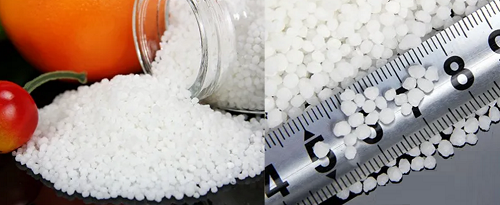
Exhibition time: 17-19 March, 2025 Shanghai, China
 中文
中文

Exhibition time: 17-19 March, 2025 Shanghai, China
 中文
中文
Calcium ammonium nitrate has long been a commonly used nitrogen fertilizer in Europe, North America, and temperate regions. It is grayish-white or gray-brown granules and has a fertilizer effect that can absorb quickly by the plant. A large number of facts show that this feature is suitable for the growth habit of many crops. Calcium ammonium nitrate is very soluble in water. The main raw materials are made of molten ammonium nitrate and limestone powder according to the proportion. The mixing standards of different manufacturers are different. Among them, nitrate nitrogen and ammonium nitrogen have much less nitrogen content, and the diameter size is 2-5mm, it has the physical characteristics of low hygroscopicity, not easy to cake and good dispersion.

Although calcium ammonium nitrate is said to contain a calcium element, the main nutrients are nitrate nitrogen and ammonium nitrogen, which are high-quality nitrogen fertilizers. Moreover, calcium ammonium nitrate is an upgraded alternative to ammonium nitrate. Due to the flammable and explosive characteristics of ammonium nitrate, it has a greater risk of accidents so it is under strict control during production, operation, transportation, and use. Calcium ammonium nitrate is more stable than ammonium nitrate in chemical properties through different production methods, and it also has the function of supplementing calcium elements in terms of functionality. It is a high-quality substitute to ammonium nitrate.

The principle of the “Booster” - Calcium Ammonium Nitrate
Plants transport nitrate nitrogen and calcium ions to the roots, stems, leaves, flowers, and fruits through the transpiration of the roots, which is directly absorbed. This is the principle that calcium ammonium nitrate has rapid supplements of nitrogen and calcium because of its quick-acting nature, also called "Booster". According to the experience of farmers, the effect can be achieved within 3 hours after fertilization with calcium ammonium nitrate, and the effect is obvious after 3 days. Because of its fully water-soluble properties, foliar spraying is also a good choice. It can be diluted with 800-1000 times solution and it can be used in combination with other pesticides or foliar fertilizers, with strong compound.

Nutrient composition of Calcium Ammonium Nitrate
The components of Calcium Ammonium Nitrate are nitrate nitrogen, ammonium nitrogen and calcium. The products of different manufacturers have certain differences in nutrient composition. The total content of nitrate nitrogen and ammoniacal nitrogen is generally between 15.5-27%, and the content of calcium is about 19-20%. In addition to the rapid supplementation of nitrate nitrogen and ammonium nitrogen, it can also supplement the calcium needed for crop growth. Calcium ammonium nitrate generally contains a small amount of iron, magnesium, boron and other elements, and the element content is relatively rich.

Characteristics of calcium ammonium nitrate
Calcium ammonium nitrate is also one of the high-quality compound fertilizers. It has less impact on the soil, the amount of acid and alkali residues and salt ions remaining in the soil is small. It is conducive to the release of some nutrients in the soil and can improve the fertilizer utilization rate and quickly provide fast-acting nitrogen components that can be absorbed by crops.

Benefits of the “Booster” calcium ammonium nitrate
1. Little effect on soil acidity and alkalinity. Calcium ammonium nitrate is a weak acidic compound fertilizer. Because nitrate nitrogen and ammonium nitrogen have strong freeness in soil and high absorption rate in the soil, the chance of causing a large amount of acid ions to remain in soil is relatively small. The calcium carbonate component in the soil will only release carbon dioxide and calcium ions that can be absorbed after being decomposed in the soil, and it is difficult to directly affect the pH value of the soil. Therefore, the effect of calcium ammonium nitrate on the acidity and alkalinity of the soil is relatively small.
2. The amount of acid, alkali, ion and salt ion remaining in the soil is relatively small. The nitrogen components of calcium ammonium nitrate are nitrate nitrogen and ammonium nitrogen, which have strong freeness in the soil and are convenient for root absorption of crops. Moreover, nitrate nitrogen and ammonium nitrogen can be directly absorbed by crops without the transformation of microorganisms and physicochemical effects in the soil, the absorption rate is relatively high and fast response to fertilizer effect; followed by the calcium carbonate component, except After the decomposition, the free calcium ions are absorbed, and the remaining calcium ions will also combine with sulfate ions and other acid ions in the soil to form precipitated substances such as calcium sulfate. It is also difficult to effectively free them in the soil.
3. It can improve the freeness of other ions and improve the utilization rate of fertilizer. After applying calcium ammonium nitrate to the soil, it will increase the content of nitrate nitrogen and ammonium nitrogen in the soil. When the nitrogen content in the soil increases, it can boost the nutrient release of magnesium and phosphorus in the soil, and can increase the utilization rate of magnesium and phosphorus. For calcium, the freeness in the soil is poor, and it will not affect the freeness and utilization of potassium, magnesium, and iron in the soil.
